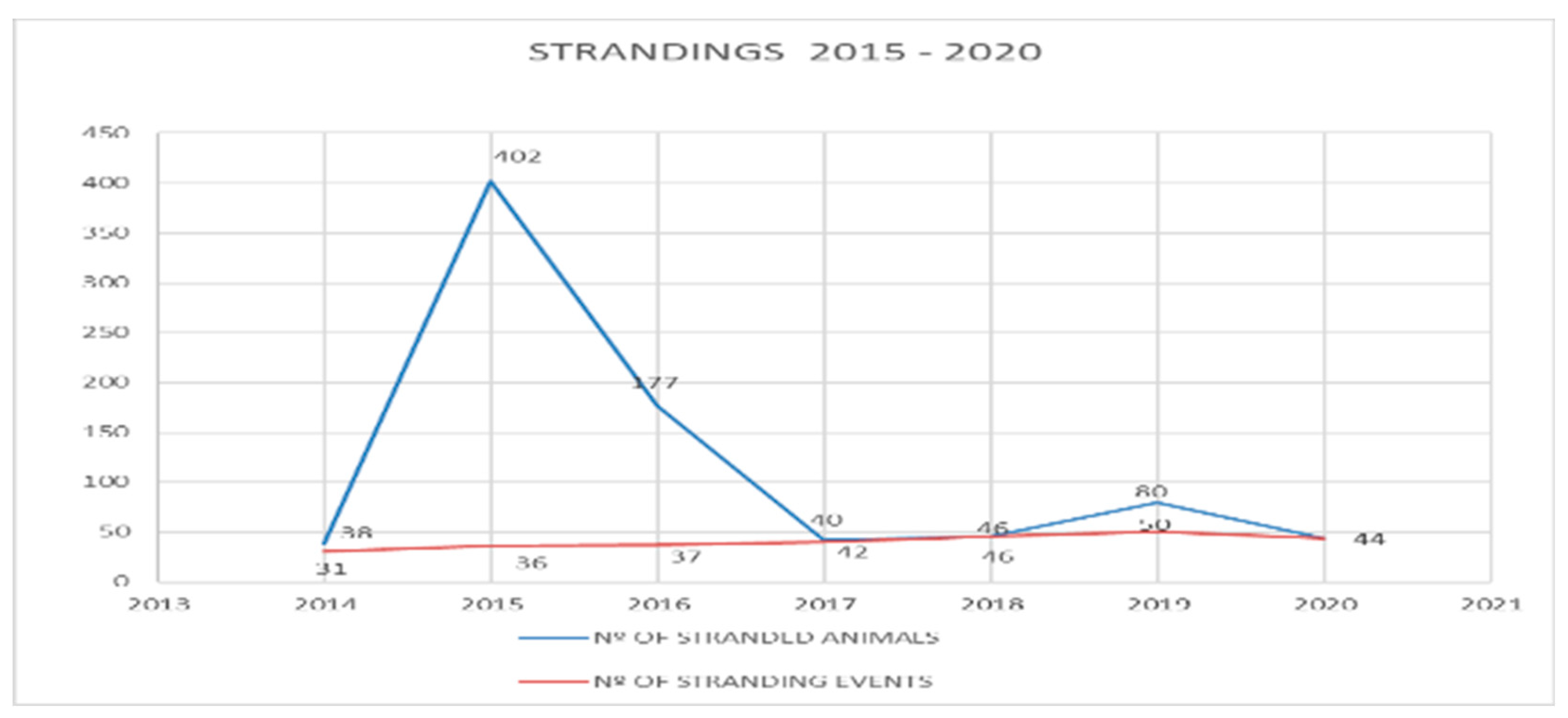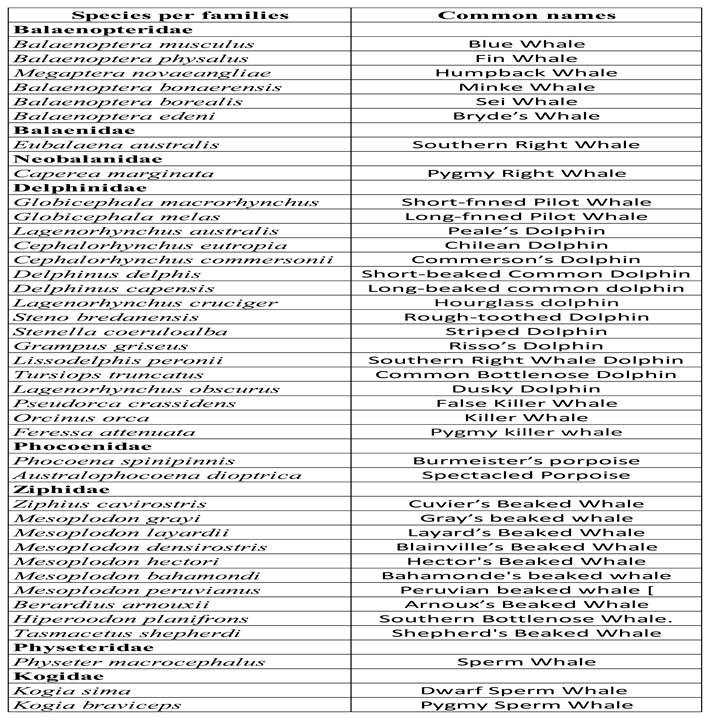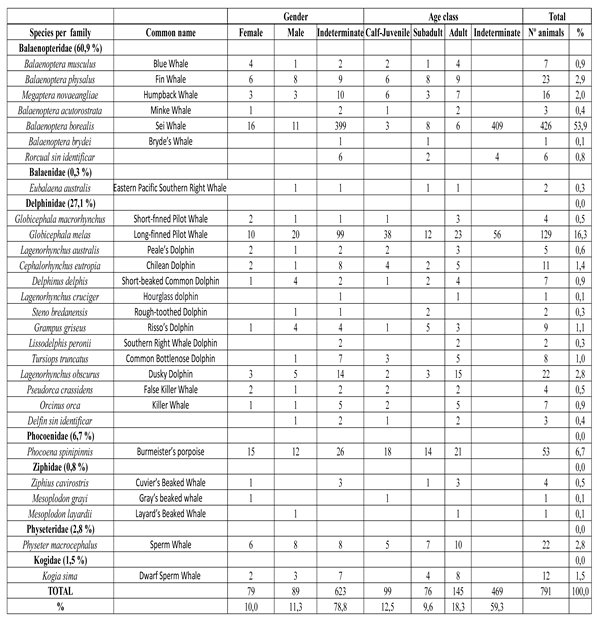Submitted:
21 August 2023
Posted:
23 August 2023
You are already at the latest version
Abstract
Keywords:
1. Introduction
1.1. Probable Causes of Strandings in Chile
1.1.1. Anthropic Factors.
1.1.2. Natural Factors
2. Materials and Methods
3. Results
3.1. Strandings between Years 2015 and 2020. The Number of Stranding Events Has Remained Relatively Stable (Figure 1), Showing a Gradual Increase between the years 2015 and 2019, counting 36, 37, 42, 45 and 46 Stranding Events, for Each Year Respectively. However, during the Year 2020 There Was a Slight Drop (43 Registered Events), and There May be a Bias in the Number of Records, Associated with Less Vigilance due to Movement Restrictions during the COVID-19 Pandemic. On the Other Hand, the Number of Stranded Animals Were by far Higher than the Number of Events, Being the Largest Number in the Summer of Year 2015, Counting 402 Specimens of sei Whale (Balaenoptera Borealis) due to the Contribution of the Massive, Unusual Mortality Event (UME) of Mysticetes Occurred in the Golfo de Penas, Aysén Region, in the Central Patagonia of Chile (Ulloa et al., 2016)
3.2. Strandings by Species, Sex and Age
3.3. Strandings by Geographic Location
3.4. Strandings according to Vital Status
3.5. Strandings by Sex of Animals
3.6. Strandings by Age of Animals
3.7. Necropsies or Biological Sampling
3.8. Probable Causes of Strandings 2015-2020
- Asphyxiation by submersion: Burmeister’s porpoise (4). Total 4
- Collision with vessels: fin whale (5), blue whale (2), minke whale (1), Chilean dolphin (1), Burmeister’s porpoise (2), humpback whale (2), sperm whale (1), dusky dolphin (1), short- beaked common dolphin (1), and unidentified whale (2). Total 18
- Predation: sei whale (2) and Burmeister’s porpoise (1). Total 3
- Disorientation by geography: long finned pilot whale (1). Total 1
- Disorientation associated with acoustic trauma: long finned pilot whale (124). Total 124
- Entanglement: fin whale (3), humpback whale (5), southern right whale (2), sei whale (2), sperm whale (2), dwarf sperm whale (2), Chilean dolphin (5), short-beaked common dolphin (1), southern right whale dolphin (1), Burmeister’s porpoise (5), killer whale (5), Blue whale (1). Total 33
- Biotoxin poisoning: sei whale (367). Total 367
3.9. Probable Causes of Death
4. Discussion
5. Conclusions
References
- Aguayo, A., D. Torres, and J. Acevedo, 1998: Los mamíferos de Chile: I. Cetacea. 48, 19–169.
- Alvarado-Rybak, M., D. Haro, P.A. Oyarzún, C. Dougnac, J. Gutierrez, N. Toledo, N. Leiva, C. Peña, C. Cifuentes, N. Muñoz, E. Montti, D. Casado, F. Toro, C. Soto-Azat, and B. Pincheira, 2019: A Mass Stranding Event of Long-Finned Pilot Whales (Globicephala melas) in Southern Chile. Aquat Mamm 45, 447–455. [CrossRef]
- Alvarado-Rybak, M., F. Toro, P. Abarca, E. Paredes, S. Español-Jiménez, and M. Seguel, 2020: Pathological Findings in Cetaceans Sporadically Stranded Along the Chilean Coast. Front. Mar. Sci. 7, 684. [CrossRef]
- Alvarado-Rybak, M., F. Toro, J. Escobar-Dodero, A.C. Kinsley, M.A. Sepúlveda, J. Capella, C. Azat, G. Cortés-Hinojosa, N. Zimin-Veselkoff, and F.O. Mardones, 2020: 50 Years of Cetacean Strandings Reveal a Concerning Rise in Chilean Patagonia. Sci Rep 10, 9511. [CrossRef]
- AMEVEFAS, 2017: Manual de necropsia de odontoceto.
- Arata, J., and R. Hucke-Gaete, 2005: Pesca Incidental de Aves y Mamíferos Marinos.
- Avila, I.C., K. Kaschner, and C.F. Dormann, 2018: Current global risks to marine mammals: Taking stock of the threats. Biological Conservation 221, 44–58. [CrossRef]
- Baulch, S., and C. Perry, 2014: Evaluating the impacts of marine debris on cetaceans. Mar Pollut Bull 80, 210–221. [CrossRef]
- Bejder, L., A. Samuels, H. Whitehead, N. Gales, J. Mann, R. Connor, M. Heithaus, J. Watson-Capps, C. Flaherty, and M. Krützen, 2006: Decline in Relative Abundance of Bottlenose Dolphins Exposed to Long-Term Disturbance. Conservation Biology 20, 1791–1798. [CrossRef]
- Bengston, D.N., 2016: The Futures Wheel: A Method for Exploring the Implications of Social–Ecological Change. Society & Natural Resources 29, 374–379. [CrossRef]
- Bezamat, C., L.L. Wedekin, and P.C. Simões-Lopes, 2015: Potential ship strikes and density of humpback whales in the Abrolhos Bank breeding ground, Brazil: POTENTIAL SHIP STRIKES OF HUMPBACK WHALES OFF BRAZIL. Aquatic Conserv: Mar. Freshw. Ecosyst. 25, 712–725. [CrossRef]
- Brakes, P., and M.P. Simmonds (Eds.), 2011: Whales and Dolphins: Cognition, Culture, Conservation and Human Perceptions. London: Earthscan.
- Brownell, R.L., B.G. Vernazzani, and C.A. Carlson, 2009: Vessel collision with a large whale off southern Chile.
- Cáceres, B., 2016: Interaccion entre la pesquería del bacalao de profundidad, Dissostichus eleginoides (Nototheniidae), con el cachalote y la orca en el sur de Chile. Anaes intituto patagonia 44, 21–38. [CrossRef]
- Cámara, S., F. Esperón, A. De la Torre, M. Carballo, S. Aguayo, M. Muñoz, and M.J. Sanchez-Vizcaino, 2003: Inmunotoxicidad en cetáceos. Parte I: metales pesados. Revista cararia de las ciencias veterinarias16.
- Campoy, P., and R. Beiras, 2019: Revisión: efectos ecológicos de macro. meso y microplásticos.
- CCC, 2008: Informe anual 2008.
- CCC, 2009: Informe anual 2009. Centro de conservación cetacea.
- Centro de conservación cetácea, 2008: Informe anual 2009.
- Christiansen, F., D. Lusseau, E. Stensland, and P. Berggren, 2010: Effects of tourist boats on the behaviour of Indo-Pacific bottlenose dolphins off the south coast of Zanzibar. Endang. Species. Res. 11, 91–99. [CrossRef]
- Christiansen, F., M. Rasmussen, and D. Lusseau, 2013: Whale watching disrupts feeding activities of minke whales on a feeding ground. Mar. Ecol. Prog. Ser. 478, 239–251. [CrossRef]
- Colpaert, W., R.L. Briones, G. Chiang, and L. Sayigh, 2016: Blue whales of the Chiloé-Corcovado region, Chile: Potential for anthropogenic noise impacts. p. 040009. Presented at the Fourth International Conference on the Effects of Noise on Aquatic Life, Dublin, Ireland.
- De Siqueira, A., S.E.C. Cuevas, F.A. Salvagni, and P.C. Maiorka, 2016: Forensic Veterinary Pathology: Sharp Injuries in Animals. Vet Pathol 53, 979–987. [CrossRef]
- Elías, R., 2015: Mar del plástico: una revisión del plástico en el mar. Rev. Invest. Dessar. Pesq.83–105.
- Farré, J., 2005: Protocolos especiales de las redes de varamiento y centros de recuperación, para la monitorización de los efectos de las prospecciones sísmicas en la fauna marina, especialmente en los cetáceos.
- Fernández, A., J.F. Edwards, F. Rodríguez, A.E. De Los Monteros, P. Herráez, P. Castro, J.R. Jaber, V. Martín, and M. Arbelo, 2005: “Gas and Fat Embolic Syndrome” Involving a Mass Stranding of Beaked Whales (Family Ziphiidae) Exposed to Anthropogenic Sonar Signals. Vet Pathol 42, 446–457. [CrossRef]
- Fretwell, P.T., J.A. Jackson, M.J. Ulloa Encina, V. Häussermann, M.J. Perez Alvarez, C. Olavarría, and C.S. Gutstein, 2019: Using remote sensing to detect whale strandings in remote areas: The case of sei whales mass mortality in Chilean Patagonia. (Atsushi Fujimura, Ed.)PLoS ONE 14, e0222498. [CrossRef]
- Galletti, B., and E. Cabrera, 2007: Varamiento de cetáceos en Chile 1970-2005 y su relación con impactos antropogénicos.
- Garcia-Cegarra, A.M., J. De A. Padilha, B.F. Braz, R. Ricciardi, W. Espejo, G. Chiang, and P. Bahamonde, 2020: Concentration of trace elements in long-finned pilot whales stranded in northern Patagonia, Chile. Marine Pollution Bulletin 151, 110822. [CrossRef]
- Geraci, J., and V.J. Lounsbury, 2005: Marine Mammals Ashore: A Field Guide for Strandings. National Aquarium in Baltimore.
- Hamilton, L.J., 2018: Large mass strandings of selected odontocete species: statistics, locations, and relation to earth processes. J. Cetacean Res. Manage. 19, 57–78. [CrossRef]
- Häussermann, V., C.S. Gutstein, M. Beddington, D. Cassis, C. Olavarria, A.C. Dale, A.M. Valenzuela-Toro, M.J. Perez-Alvarez, H.H. Sepúlveda, K.M. McConnell, F.E. Horwitz, and G. Försterra, 2017: Largest baleen whale mass mortality during strong El Niño event is likely related to harmful toxic algal bloom. PeerJ 5, e3123. [CrossRef]
- Helm, R.C., D.P. Costa, T.D. DeBruyn, T.J. O’Shea, R.S. Wells, and T.M. Williams, 2015: Overview of Effects of Oil Spills on Marine Mammals, pp. 455–475. In: Fingas, Merv (ed), Handbook of Oil Spill Science and Technology. Hoboken, NJ: John Wiley & Sons, Inc.
- Hucke-Gaete, R., 2006: Conservación Marina En El Sur de Chile.
- IFOP, 2020: Informe final. Programa de observadores cientificos: programa de investigación y monitoreo del descarte y la captura de pesca incidental en pesquerias pelágicas 2019-2020.
- INE, 2017: Informe anual 2017. Instituto nacional de estadística.
- Isasi Catalá, E., 2011: Los conceptos de especies indicadoras, paraguas, banderas y claves: su uso y abuso en ecología de la conservación. Interciencia 36, 31–38.
- Jackson, J.A., E.L. Carroll, T.D. Smith, A.N. Zerbini, N.J. Patenaude, and C.S. Baker, 2016: An integrated approach to historical population assessment of the great whales: case of the New Zealand southern right whale. R. Soc. open sci. 3, 150669. [CrossRef]
- Jepson, P.D., and R.J. Law, 2016: Persistent pollutants, persistent threats. Science 352, 1388–1389. [CrossRef]
- Lavery, T.J., B. Roudnew, J. Seymour, J.G. Mitchell, V. Smetacek, and S. Nicol, 2014: Whales sustain fisheries: Blue whales stimulate primary production in the Southern Ocean. Mar Mam Sci 30, 888–904. [CrossRef]
- Mazzariol, S., G. Di Guardo, A. Petrella, L. Marsili, C.M. Fossi, C. Leonzio, N. Zizzo, S. Vizzini, S. Gaspari, G. Pavan, M. Podestà, F. Garibaldi, M. Ferrante, C. Copat, D. Traversa, F. Marcer, S. Airoldi, A. Frantzis, Y. De Bernaldo Quirós, B. Cozzi, and A. Fernández, 2011: Sometimes Sperm Whales (Physeter macrocephalus) Cannot Find Their Way Back to the High Seas: A Multidisciplinary Study on a Mass Stranding. (Dirk Steinke, Ed.)PLoS ONE 6, e19417. [CrossRef]
- Moazzam, M., 2013: An assessment of the cetacean mortality in the gillnet fishery of the northen arabian sea p. 89. Karachi, Pakistán.
- Moore, T.J., J.V. Redfern, M. Carver, S. Hastings, J.D. Adams, and G.K. Silber, 2018: Exploring ship traffic variability off California. Ocean & Coastal Management 163, 515–527. [CrossRef]
- Moreno, C., R. Hucke-Gaete, and J. Arata, 2003: Interacción de la pesquería del bacalao de profundidad con mamíferos y aves marinas.
- Obusan, M.C.M., W.L. Rivera, M.A.T. Siringan, and L.V. Aragones, 2016: Stranding events in the Philippines provide evidence for impacts of human interactions on cetaceans. Ocean & Coastal Management 134, 41–51. [CrossRef]
- Ottensmeyer, C.A., and H. Whitehead, 2003: Behavioural evidence for social units in long-finned pilot whales. Can. J. Zool. 81, 1327–1338. [CrossRef]
- Pacheco, A.S., V.K. Villegas, J.M. Riascos, and K. Van Waerebeek, 2015: Presence of fin whales (Balaenoptera physalus) in Mejillones Bay, a major seaport area in northern Chile. Rev. biol. mar. oceanogr. 50, 383–389. [CrossRef]
- Parsons, E.C.M., 2012: The Negative Impacts of Whale-Watching. Journal of Marine Biology 2012, 1–9. [CrossRef]
- Perrin, W.F., B.G. Würsig, and J.G.M. Thewissen (Eds.), 2002: Encyclopedia of Marine Mammals. San Diego: Academic Press.
- Pinzone, M., H. Budzinski, A. Tasciotti, D. Ody, G. Lepoint, J. Schnitzler, G. Scholl, J.-P. Thomé, N. Tapie, G. Eppe, and K. Das, 2015: POPs in free-ranging pilot whales, sperm whales and fin whales from the Mediterranean Sea: Influence of biological and ecological factors. Environmental Research 142, 185–196. [CrossRef]
- Poeta, G., E. Staffieri, A.T.R. Acosta, and C. Battisti, 2017: Ecological effects of anthropogenic litter on marine mammals: A global review with a “black-list” of impacted taxa. Hystrix It. J. Mamm. 28, 253–264. [CrossRef]
- Powell, S.N., M.M. Wallen, S. Bansal, and J. Mann, 2018: Epidemiological investigation of tattoo-like skin lesions among bottlenose dolphins in Shark Bay, Australia. Science of The Total Environment 630, 774–780. [CrossRef]
- Quaggiotto, M.-M., J.A. Sánchez-Zapata, D.M. Bailey, A. Payo-Payo, J. Navarro, A. Brownlow, R. Deaville, S.A. Lambertucci, N. Selva, A. Cortés-Avizanda, F. Hiraldo, J.A. Donázar, and M. Moleón, 2022: Past, present and future of the ecosystem services provided by cetacean carcasses. Ecosystem Services 54, 101406. [CrossRef]
- Sepulveda, M., M. Santos-Carvallo, and G. Pavez, 2017: Whale-Watching En La Reserva Marina Isla Chañaral: Manejo y Planificación Para Una Actividad Sustentable.
- SERNAPESCA, 2020: Rescates y varamientos de fauna marina 2019.
- Sierra, E., A. Fernández, A. Espinosa De Los Monteros, M. Arbelo, J. Díaz-Delgado, M. Andrada, and P. Herráez, 2014: Histopathological Muscle Findings May Be Essential for a Definitive Diagnosis of Suspected Sharp Trauma Associated with Ship Strikes in Stranded Cetaceans. (Andreas Fahlman, Ed.)PLoS ONE 9, e88780. [CrossRef]
- Smith, C.R., A.G. Glover, T. Treude, N.D. Higgs, and D.J. Amon, 2015: Whale-Fall Ecosystems: Recent Insights into Ecology, Paleoecology, and Evolution. Annu. Rev. Mar. Sci. 7, 571–596. [CrossRef]
- Starrantino, C., 2018: Effects of pollutants on the immune system of cetaceans. PhD thesis, Universidad de La Laguna.
- Ulloa, M.J., R. Hucke-Gaete, L. Bedriñana-Romano, V. Häussermann, C. Simon-Gutstein, M.J. Perez-Alvarez, D. Cassis, G. Garrido, B. Cáceres, C. Calderon, and A. Aguayo, 2016: Unusual mass mortality event of rorqual whales in de Gulf of Penas, Chile, during 2015.
- Williams, O., 2018: Biological and Abiotic Factors Influencing Cetacean Mass Strandings in the Northeastern United States. HCNSO Student Capstones.
- Williams, R., A.J. Wright, E. Ashe, L.K. Blight, R. Bruintjes, R. Canessa, C.W. Clark, S. Cullis-Suzuki, D.T. Dakin, C. Erbe, P.S. Hammond, N.D. Merchant, P.D. O’Hara, J. Purser, A.N. Radford, S.D. Simpson, L. Thomas, and M.A. Wale, 2015: Impacts of anthropogenic noise on marine life: Publication patterns, new discoveries, and future directions in research and management. Ocean & Coastal Management 115, 17–24. [CrossRef]
- Würsig, B.G., J.G.M. Thewissen, and K.M. Kovacs (Eds.), 2018: Encyclopedia of Marine MammalsThird edition. London, United Kingdom ; San Diego, CA, United States: Academic Press, an imprint of Elsevier.

 |
 |
Disclaimer/Publisher’s Note: The statements, opinions and data contained in all publications are solely those of the individual author(s) and contributor(s) and not of MDPI and/or the editor(s). MDPI and/or the editor(s) disclaim responsibility for any injury to people or property resulting from any ideas, methods, instructions or products referred to in the content. |
© 2023 by the authors. Licensee MDPI, Basel, Switzerland. This article is an open access article distributed under the terms and conditions of the Creative Commons Attribution (CC BY) license (http://creativecommons.org/licenses/by/4.0/).




